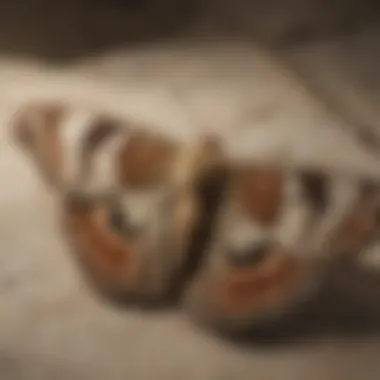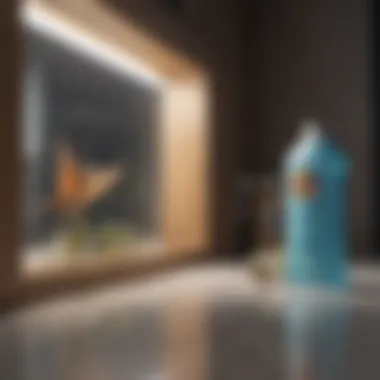Effective Moth Prevention Strategies for Closets


Intro
Moths can be a hidden enemy in our closets. Often, we don’t realize their presence until damage has been done. These pests thrive on natural fibers found in clothing, leading to potential loss of treasured garments. Knowing how to prevent moth infestations is essential for maintaining our closets and safeguarding our belongings.
To effectively tackle this issue, one must understand moth behavior. Recognizing the signs of an infestation can be the first step in prevention. Additionally, implementing strategies for storage and cleaning can significantly reduce risk. Utilizing natural deterrents can further enhance the protective measures taken against these unwanted visitors.
In this article, we will explore the necessary steps to prevent moth problems in closets. We will discuss practical storage techniques, optimal cleaning methods, and several natural remedies that can repel moths. By understanding and performing preventive actions, individuals can ensure a moth-free environment.
Understanding Moths
The Life Cycle of Moths
Moths undergo a distinct life cycle, which consists of four stages: egg, larva (caterpillar), pupa, and adult. The cycle begins when the female moth lays eggs. These eggs are often laid on or near potential food sources, which can include fabrics and organic materials in a closet. After a few days, the eggs hatch into larvae, the stage most destructive to clothing.
During the larval stage, moths feed on natural fibers from clothes, such as wool or silk. This feeding behavior is what leads to holes and damage in clothing items. When the larvae have matured, they spin cocoons and enter the pupal stage. This stage lasts for a few weeks, after which the adult moth emerges. Understanding this cycle is crucial because targeting the larvae and preventing adult moths from laying eggs can effectively reduce infestations.
Common Types of Moths in Closets
There are several species of moths that can commonly find their way into closets. The two most prevalent ones are the Clothes Moth, specifically the Webbing Clothes Moth and the Casemaking Clothes Moth, and the Pantry Moth, also known as the Indian Meal Moth.
Webbing Clothes Moth: This type is small, with a wingspan of about half an inch. They prefer to lay eggs in dark areas where old clothing is stored.
Casemaking Clothes Moth: Slightly larger than their webbing counterpart, they are known for their unique behavior of building small protective casings from fibers, which they carry with them.
Indian Meal Moth: This species typically infests stored food but may sometimes venture into closets, attracted by natural fibers in clothing.
Recognizing these types can help in identifying specific infestations and applying the right prevention strategies.
Behavioral Patterns of Moths
Moths exhibit particular behaviors that can aid in their identification and prevention. They are nocturnal creatures, becoming more active at night, which is when they typically search for food. This behavior means moths often go unnoticed during the day, making infestations harder to detect.
In terms of attraction, moths are drawn to light and have a strong olfactory sense. They tend to prefer dark, undisturbed areas for laying eggs. Closets provide an ideal environment because they are often dark, undisturbed, and contain materials that support moth larvae development. Moths are also capable of flying significant distances to locate food.
By understanding these behavioral patterns, homeowners can make informed decisions on how to set traps and deter moths effectively. Regular inspections and strategic use of light can be beneficial in identifying and eradicating moths before they cause damage.
Understanding moths is the first step towards prevention. Know what you are dealing with to take action effectively.
Identifying Moth Infestations
Identifying moth infestations is crucial for maintaining a healthy living space. Early detection can safeguard clothing and fabrics from damage, ensuring that homes remain both aesthetically pleasing and functional. Moths, if left unchecked, can lead to significant material loss. This section will explore the various indicators of moth presence, how to distinguish between species, and advice on when to contact pest professionals.
Signs of Moth Presence
To effectively combat moth infestations, it is necessary to recognize the signs of their presence. Typical indicators include:
- Visible Damage: Look for holes or frayed edges in clothing and fabric materials. Moths prefer natural fibers such as wool, silk, and cotton, which are more susceptible.
- Cast Skins: As moths mature, they shed their skins, which can often be found near infested areas.
- Webbing: Some species, like the webbing clothes moth, create webbings within stored fabrics. This can indicate a more severe infestation.
- Cocoons: These can appear in dark corners or within clothes, often indicating a developing life stage of the larvae.
- Moth Droppings: Small, black specks resembling pepper can often be found where moths have fed.
Paying close attention to these signs can help in prompt identification, which is essential for effective prevention and eradication.
Differentiating Between Types of Moths
Not all moths are the same; understanding the types commonly found in closets can influence prevention strategies. The two most frequently encountered moths are:


- Clothes Moths: These include the common clothes moth and the webbing clothes moth. They tend not to fly much and prefer dark, secluded places, making identification difficult without closer inspection.
- Pantry Moths: These are usually found around food products. Their larvae infest grains, cereals, and dried goods rather than clothing.
Differentiating between these types helps in choosing the right prevention methods. For example, clothes moths require different monitoring than pantry moths. Familiarity with these distinctions can simplify management and help in effectively eliminating the problem.
When to Seek Professional Help
Recognizing when to enlist professional assistance is vital. If inspections confirm an extensive infestation, or if the moth damage already threatens valuable items, it is time to consult a pest control expert. Additional scenarios warranting professional assessment include:
- Persistent Signs: If signs continue despite implementing preventive measures.
- Unclear Identification: When unsure about the specific type of moth causing damage.
- Widespread Infestation: If the presence of moths extends beyond the closet into other areas of the home.
A professional can provide a comprehensive evaluation, applying targeted strategies to manage the situation effectively. Their expertise ensures that the situation does not worsen and protects vital items from further harm.
Key Insight: Early detection and correct identification are paramount in preventing moth infestations. Not all moth species pose the same threat, making knowledge necessary for proper management.
Preventive Measures
Preventive measures are crucial in maintaining a moth-free environment in closets. Moths can cause damage to clothing and other stored items, so taking proactive steps is essential. This section outlines various practices that can significantly decrease the likelihood of infestations. Regular upkeep of storage areas, effective handling of seasonal clothing, and proper organization not only deter moths but also promote a cleaner and more pleasant closet space. Implementing preventive measures allows individuals to enjoy their belongings without the constant fear of damage from these pests.
Regular Cleaning Practices
Vacuuming Techniques
Vacuuming is a fundamental action in the battle against moths. Regular vacuuming removes larvae, eggs, and adult moths from carpet and fabric. A key characteristic of this technique is its reach; it can remove even the smallest particles that may become breeding grounds. This makes vacuuming a popular choice for keeping closets clean.
However, one unique feature is the necessity to focus on corners and crevices where dust tends to accumulate. This is where eggs may hide unnoticed. The advantage of this technique is that it is simple and requires minimal investment, just a good vacuum cleaner. The main disadvantage might be if done infrequently, as neglected areas will still harbor infestations.
Removing Seasonal Clothing
Clearing out seasonal clothing has a significant impact on moth prevention. This practice allows for inspection of clothes for moth-related damage. By actively choosing to remove items that are currently not in use, individuals are engaging in a beneficial form of maintenance. The core characteristic of this practice is the timing. It is especially crucial before seasons change.
A unique feature of this approach is the opportunity to thoroughly clean and inspect every item before storing it away. The advantage is it often reveals any unnoticed infestations before they spread. However, the disadvantage can be the time required to sort through and clean these items effectively.
Organizing and Decluttering
Organizing and decluttering help in preventing moth infestations. A key characteristic of this method is the visibility it creates. By having your items neatly organized, it’s easier to spot potential problems. This makes it a popular choice for maintaining an effective moth prevention strategy.
A unique feature is the reduced hiding spots for moths. When there are fewer items piled together, there is less chance for moths to conceal themselves. The advantages include not only helping in pest prevention but also improving the overall aesthetic of the space. The downside might be the ongoing commitment required to maintain this organized state.
Effective Storage Solutions
Using Airtight Containers
Using airtight containers is one of the most effective storage solutions for preventing moth infestations. A key characteristic of these containers is their ability to create a barrier that moths cannot penetrate. This makes them a beneficial choice for storing clothing.
The unique feature here is the variety of options available, from plastic bins to glass jars. This adaptability makes them suitable for numerous items. The main advantage lies in their capability to keep both adult moths and larvae out. However, depending on the material and size, the cost can vary, which might limit options for some individuals.
Implementing Cedar Products
Cedar products are renowned for their insect-repellent properties. A key characteristic of cedar is its natural oils, which provide a powerful deterrent to moths. This makes cedar a popular choice in closets, providing a dual function of protection and pleasant aroma.
A unique feature of cedar is that it is safe for the environment and does not involve chemicals. The advantage is that it not only repels moths but can also absorb moisture, which is beneficial. However, the scent can fade over time, necessitating periodic replacement or re-conditioning.
Choosing the Right Fabric Softener


Choosing the right fabric softener can also contribute to moth prevention. Certain fabric softeners contain agents that are not appealing to moths. This key characteristic offers an additional layer of protection during laundry. Many people find this an easy and beneficial strategy for their closet maintenance.
A unique aspect is that the right fabric softener can leave a fresh scent, which many find appealing. The advantage here is convenience; it’s integrated into the laundering process. One downside could be allergies some individuals may have to certain chemicals in fabric softeners, which must be accounted for when making choices.
Natural Repellents
Lavender and Essential Oils
Lavender and essential oils are natural alternatives for repelling moths. A key characteristic of these remedies is their pleasant scent, which is often appealing to humans but offensive to moths. This makes them a beneficial option for closet spaces.
The unique feature of using lavender is that it can be applied in various forms—sachets, sprays, or even as a diluted oil. The advantage is they provide a non-toxic solution while keeping the environment smelling fresh. However, regular reapplication is necessary to maintain efficacy, which may be viewed as a disadvantage.
Herbal Sachets
Herbal sachets are practical for moth prevention. They typically contain a blend of dried herbs that are unappealing to moths. A key characteristic is their simplicity; anyone can make or purchase sachets. They are a popular and eco-friendly choice for closets, providing an easy method of prevention.
The unique feature is their versatility; they can be tucked into drawers, or hung in closets. The primary advantage is they are non-toxic and can add a pleasant aroma. However, they may need to be refreshed or replaced after a few months, which could be seen as a downside.
Using Vinegar Solutions
Using vinegar solutions is another effective natural repellent strategy. A key characteristic of vinegar is its strong smell, which moths tend to avoid. This makes it a beneficial and simple solution for maintaining moth-free spaces.
The unique feature of vinegar is its multiple uses, being effective as a cleaner as well. The advantage is the accessibility of vinegar; it is a common household item. However, the odor can be overwhelming, especially in high concentrations, representing a potential downside for some individuals.
Using Chemical Treatments
Chemical treatments play an essential role in managing moth infestations in closets. While natural methods can effectively deter moths, sometimes, more aggressive approaches are needed. Chemical repellents and pesticides target specific life stages of moths, ensuring a broader level of control. These treatments can penetrate fabric fibers, offering a level of protection that may not be achievable through other means. It is vital, however, to use these products with caution and to follow guidelines to prevent harm to oneself and the environment.
Types of Chemical Repellents
Several types of chemical repellents are available. These products generally fall into distinct categories based on their active ingredients:
- Synthetic Insecticides: Compounds like pyrethroids are common in household insecticides. They work by disrupting the nervous systems of moths, rendering them unable to function effectively. Products containing permethrin are notable examples.
- Pheromone Traps: These traps do not repel moths but instead lure them using synthetic pheromones. Once attracted, moths become trapped, breaking their reproductive cycle and reducing the population.
- Foggers and Aerosols: These products allow for widespread treatment of an area. They release tiny droplets of insecticide that circulate and settle in places where moths may hide.
When selecting a chemical repellent, it is advisable to choose a product that specifically indicates it is effective against moths. Always check the label for any claims about efficacy and follow the manufacturer’s instructions.
Safety Considerations
Safety cannot be overlooked when using chemical treatments. Here are several key considerations:
- Read Labels: Follow all instructions provided on the product label. This includes safety warnings, recommended dosage, and dilution guidelines.
- Ventilation: Ensure the area is well-ventilated when applying chemical treatments. Proper airflow reduces inhalation risks and improves safety.
- Protective Gear: Wear gloves and a mask when handling chemical substances. This is important to prevent skin exposure and inhalation of harmful particles.
- Keep Away from Pets and Children: Ensure that treated areas are inaccessible to pets and children until it is safe to re-enter.
- Environmental Impact: Consider the environmental effects of the chemical products. Some may be harmful to beneficial insects and the ecosystem. Always opt for lower toxicity options when possible.
Proper Application Techniques
Knowing how to apply chemical treatments correctly is vital for effectiveness and safety. Here are some techniques to consider:
- Targeted Application: Aim the treatment directly at suspected areas of infestation, such as corners, seams, and folds in clothing. This precision ensures that the chemicals make contact with the moths where they tend to linger.
- Even Coverage: Ensure even application, but avoid saturating fabrics. A light mist over surfaces works better than soaking them, which could lead to damage or discoloration.
- Timing Matters: Apply treatments during times when moths are most active, usually in the evening. This increases the chances of contact with the chemicals.
- Follow-Up Treatments: Most chemical treatments require reapplication after a specific period. Adhering to this schedule ensures continued effectiveness in preventing and eliminating moth infestations.
Proper use of chemical treatments can significantly reduce the moth population in your closets, but always prioritize safety and environmental considerations.
By implementing these strategies, homeowners can effectively use chemical treatments as part of their broader moth prevention plan.
Long-Term Strategies


Long-term strategies are essential for maintaining a moth-free environment in your closets. These approaches not only address current infestations but also help prevent future ones. Understanding how to manage your space effectively and creating a proactive plan can save time, money, and frustration. Focusing on consistent practices yields results that rely on preventive measures as lifestyle habits rather than temporary fixes.
Climate Control
Maintaining Temperature
Maintaining a stable temperature in your home plays a critical role in preventing moth infestations. Moths thrive in warm environments, so keeping closets cool can discourage their activity. Typical closet temperatures, ideally below 70 degrees Fahrenheit, are less favorable for moth reproduction. This strategy is both beneficial and popular because it utilizes existing HVAC systems and requires minimal effort once established.
A unique feature of maintaining temperature is the use of fans or air conditioning vents directed towards storage areas. These tools can create air circulation, further hindering moth nests. However, extra energy costs during hot seasons may pose a disadvantage, so balancing comfort and costs is vital.
Regulating Humidity
Regulating humidity levels is another important factor in moth prevention strategies. Moths prefer humid environments, generally over 50 percent humidity. Drying out clothes before storing them and using dehumidifiers can be effective practices. Keeping humidity below 40 percent is often desirable in the prevention framework.
A key characteristic of regulating humidity is its dual benefits—maintaining healthier fabrics and reducing the risk of mold growth. This makes it a widely recommended choice for anyone looking to protect their belongings. The use of silica gel packets or other moisture-absorbing materials can help achieve this, although consistent monitoring might be required.
Annual Moth Prevention Checklists
Preparing for Seasonal Changes
Preparing for seasonal changes is an essential part of effective moth prevention. As environmental temperatures and humidity fluctuate, moths often become active. Creating a checklist to guide your preparations ensures a comprehensive approach.
This checklist typically includes inspecting clothing and fabrics before storing them for seasonal transitions. A key characteristic of this approach is its adaptability, allowing you to make adjustments based on current conditions. It’s a beneficial choice because it encourages regular habits that can significantly reduce risks over time.
A unique feature of this preparation is the practice of rotating stored items. By accessing seldom-used clothing, you can air it out and examine it, effectively minimizing moth activity. The disadvantage may be time-consuming as seasonal changes occur multiple times a year.
Post-Moth Season Care
Post-moth season care focuses on minimizing the likelihood of future infestations. This practice involves assessing spaces after warmer months to identify any signs of moth activity or damage. It is an important strategy because it helps in mitigating any remaining risks before they escalate.
The key characteristic of post-moth season care is its proactive nature. Conducting audits of clothing, storage solutions, and cleaning methods can be beneficial. You might consider using this time to freshen up storage containers or replace repellents. The unique feature lies in its comprehensive nature—addressing everything from cleanliness to storage strategy can strengthen your defenses. It may require additional effort, but it significantly reduces the chance of a relapse.
Collaborating with Pest Control Experts
Collaborating with pest control experts brings additional expertise into your moth prevention strategy. These professionals can offer tailored advice based on your specific circumstances. They can help identify vulnerabilities in your storage methods and suggest innovative solutions.
A key aspect of working with experts is access to advanced tools and knowledge of effective treatments. This collaboration enhances your overall strategy as it supplements preventative measures with professional-grade interventions when necessary. The unique feature is the instant credibility and peace of mind it brings to your prevention efforts. The main downside might be the associated costs, but the value of expertise often justifies the investment.
Effective long-term strategies require ongoing commitment and regular evaluation to address any emerging concerns.
Epilogue
By exploring practical measures such as regular cleaning, effective storage solutions, and the use of natural repellents, individuals can significantly reduce the risk of moth invasions. The importance of an annual checklist, along with climate control, cannot be overstated. Such preventive practices ensure that closets remain safe havens for clothing and other items, rather than breeding grounds for pests.
"An ounce of prevention is worth a pound of cure." Maintaining awareness and vigilance enables homeowners to avert the distress associated with infestations.
Recap of Prevention Techniques
This section serves as a concise summary of the key prevention techniques covered throughout the article. These include:
- Regular Cleaning Practices: Regular vacuuming, seasonal removal of clothing, and maintaining a decluttered space are vital for disrupting moth life cycles.
- Effective Storage Solutions: Using airtight containers, cedar products, and selecting appropriate fabric softeners offer additional protection against moths.
- Natural Repellents: Implementing repellents like lavender, herbal sachets, and vinegar solutions can deter moths without risking harmful chemicals.
- Chemical Treatments: If necessary, knowledge about safe chemical repellents and proper application methods can be useful.
- Long-Term Strategies: Managing climate conditions and performing annual checklists help maintain an ongoing defense against moths.
By integrating these techniques into everyday habits, individuals equip themselves with the tools needed to keep their closets moth-free.
Final Thoughts on Closet Maintenance
Closet maintenance goes beyond simply avoiding moths; it encapsulates the overall care and organization of one’s belongings. It is not just about aesthetics; it deeply influences the longevity of clothing and accessories. A well-maintained closet promotes easy access to wardrobes and nurtures the clothing lifestyle.
For more information on pest control strategies and preventive measures, visit Wikipedia or Britannica.
Maintaining an informed stance on closet upkeep is essential. Practical knowledge not only helps avert potential issues but enhances overall living conditions.















